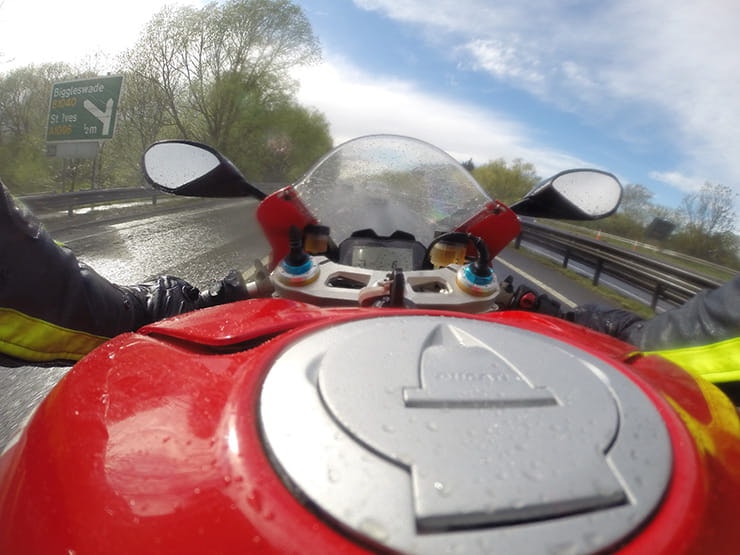Our ‘My First...’ series offers easy-to-remember advice in a bullet point-style for a selection of first times on a bike; from the first time you get a puncture to the first time you change your oil, we’ve got some top tips to help you out.
It’s the moment you’ve been dreading. Fresh from passing your CBT you’re about to go out on your bike and it starts lashing down. Here are the 8 steps to coping with and – you never know – even enjoying your first wet ride.
Vision is the most important factor in a safe, relaxed wet ride. Without that, riding in the rain is hellish and dangerous. So, get a Pinlock insert for your visor. This does two things: a) stops your visor misting up (it’s like double glazing) and b) means you don’t have to open your visor at junctions to stop misting, so rain doesn’t dribble in on the inside, where you can’t wipe it off. Pinlocks vary in price from £15-25 but are worth every penny. If your left glove doesn’t have a wiper blade on it, buy a Vee Wipe – this fits on your finger and acts as a windscreen wiper. Leather gloves will just smear the water and it’ll be like peering through a shower curtain.
Sort your kit. Besides being soul-destroying, getting cold and wet will wreck your concentration and increase risks. You can pay over £1000 for Gore-Tex textile suits, but a waterproof oversuit will keep the rain out for £35. Wear it over your leathers, and make sure it’s a close fit or the flapping will drive you nuts. Most fold into their own pocket for easy storage – some will even buckle round your waist to make carrying easy. Waterproof gloves are essential too – cold hands will be clumsy on the throttle and front brake, which is precisely what you don’t need in the rain. Around £40 will get you a budget pair that will protect your hands if you fall off. Waterproof boots should be the lowest priority – sturdy work boots will keep your feet dry for a while anyway and if your feet get wet it’s usually annoying rather than safety-critical. Oh and tuck your gloves into your jacket cuffs otherwise the rain will run down your arms and fill them up.
Believe in your tyres. If your bike has modern sports touring or road-biased adventure tyres, the grip in the wet will be phenomenal. That doesn’t mean you can go berserk, but it does mean you can relax, which is essential for the bike to respond correctly (see 5). Wet roads do not turn into ice rinks above 0C. In fact the average drop off in the coefficient of friction (COF) from dry tarmac to wet is 0.7 to 0.5. That’s a 30% drop – significant, but not as dramatic as most riders believe. If you’re dubious, try locking the rear wheel (or triggering the ABS) when it’s safe to do so on a wet road. You’ll be surprised how much effort it takes. Similarly, practice emergency stops in the wet. Use a quiet road, build up slowly, and feel how much front tyre grip you’ve got. If something does pull out on you, you’ll be much better prepared. Incidentally, when it’s icy the COF drops to 0.1 – that’s when you have to worry.
Ride for grip. If you see anything shiny – polished tarmac, tar, paint, manhole covers etc – take a line that avoids them, even if it compromises your view. You have to be careful not to target fixate – instead of staring at a dodgy-looking white line, log it, steer to avoid it and move your head and eyes to look ahead.
If you’re prone to getting tense, keep shaking your elbows. This reminds you to stay relaxed which makes a huge difference to how the bike responds. If you’re tense it’s like having the world’s biggest steering damper attached to the bars, which it prevents the bike steering sweetly. This is why riders often report that their bike doesn’t handle well in the wet.
Keep all your inputs slightly smoother than normal – tipping into corners, accelerating and braking should all be done with greater finesse in the wet so as not to risk overloading the tyres. It’s a good way to practice becoming a smoother rider.
Beware certain tyres in the wet. Brand new ones may be coated in a releasing agent which can be very slippery. Old tyres can also be perilous, partly because old tyres weren’t great in the wet anyway, and partly because they may have lost their flexibility. If you’ve just bought a bike that’s been laid up for years, go steady. And finally, fancy-pants track-biased tyres are often rubbish in the wet because they can’t warm up and therefore offer pitiful grip.
Enjoy it! If you’re warm, dry, can see properly and trust your tyres there’s absolutely no reason you can’t have a ball on wet roads.
Share on social media:

